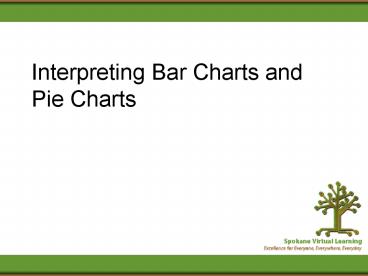Interpreting Bar Charts and Pie Charts - PowerPoint PPT Presentation
1 / 11
Title:
Interpreting Bar Charts and Pie Charts
Description:
Interpreting Bar Charts and Pie Charts Interpreting Bar Charts and Pie Charts In this presentation Bar charts Pie Charts Interpretation Guidelines Bar Charts Bar ... – PowerPoint PPT presentation
Number of Views:899
Avg rating:3.0/5.0
Title: Interpreting Bar Charts and Pie Charts
1
Interpreting Bar Charts and Pie Charts
2
Interpreting Bar Charts and Pie Charts
- In this presentation
- Bar charts
- Pie Charts
- Interpretation Guidelines
3
Bar Charts
- Bar Charts are used to display qualitative data
- Bar charts may display
- Counts (or frequencies)
- Percentages
- Proportions
- This allows comparison between categories.
4
Bar Charts
- The vertical scale is the frequency, relative
frequency, or percentage. - This is critically important to recognize and
should be labeled. - Frequencies are raw counts. That is, how many
individuals prefer each of the colors. - Relative frequencies are really proportions
(usually decimals). To find the relative
frequencies, divide the frequency by the total
(for red, 11/25 or .44). - Percentages are relative frequencies expressed as
percentages (for red, 44). - See the example.
5
Bar Charts
- The horizontal scale shows the different
categories (sometimes multiple categories are
lumped together into an other category).. - All bars should have the same width.
- There are gaps between the bars (since there is
no connection between them) - Categories may be listed in any order.
- More complicated bar charts exist (such as
stacked or side-by-side).
6
Bar Chart Example
Back to slide 4 on Bar Charts
7
Pie Charts
- A circle is divided up proportionately to show
what percentage of the total each category
represents. - They convey information regarding only the
relative size of categories (because of this,
they may mislead as totals remain unknown).
8
Pie Chart Example
9
Interpretation Guidelines
- Carefully read all labels (title, axes, bars, pie
segments, etc.) including the units and scale (be
sure to note the scales starting point). - Identify (if possible) the source of the data. Is
there sufficient reason to suspect the source may
be attempting to persuade? In what way?
10
Interpretation Guidelines
- Consider and watch for extreme values or other
possible anomalies. - Do the bars or pie sections represent counts or
relative counts? - If there are multiple displays, are their scales
and axes consistent?
11
Interpreting Bar Charts and Pie Charts
- This concludes the presentation


















![Construction and Interpretation of Simple Diagrams and Graphs [I] PowerPoint PPT Presentation](https://s3.amazonaws.com/images.powershow.com/7658618.th0.jpg?_=20160307021)












